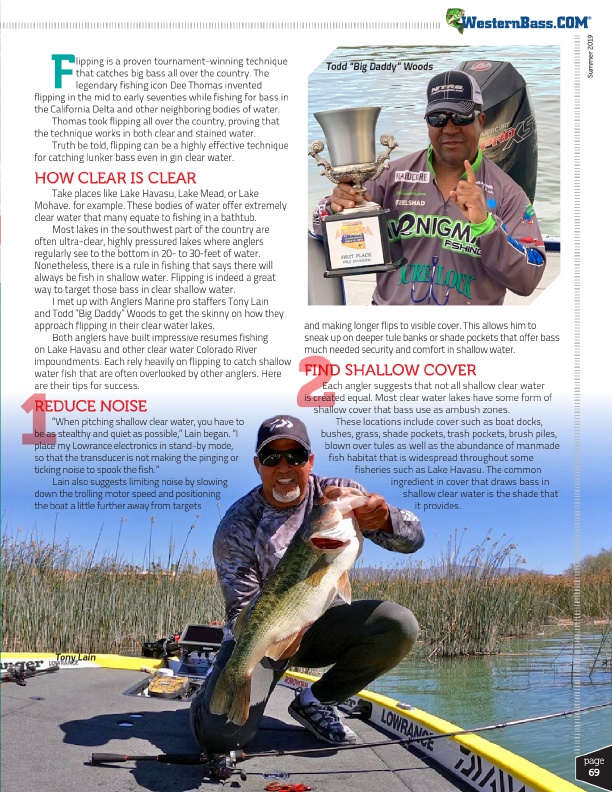
Summer 2019
1 2 F
lipping is a proven tournament-winning technique
that catches big bass all over the country. The
legendary fishing icon Dee Thomas invented flipping in the mid to early seventies while fishing for bass in
the California Delta and other neighboring bodies of water.
Thomas took flipping all over the country, proving that
the technique works in both clear and stained water.
Truth be told, flipping can be a highly effective technique
for catching lunker bass even in gin clear water.
HOW CLEAR IS CLEAR
Take places like Lake Havasu, Lake Mead, or Lake Mohave. for example. These bodies of water offer extremely clear water that many equate to fishing in a bathtub.
Most lakes in the southwest part of the country are often ultra-clear, highly pressured lakes where anglers regularly see to the bottom in 20- to 30-feet of water. Nonetheless, there is a rule in fishing that says there will always be fish in shallow water. Flipping is indeed a great way to target those bass in clear shallow water.
I met up with Anglers Marine pro staffers Tony Lain and Todd “Big Daddy” Woods to get the skinny on how they approach flipping in their clear water lakes.
Both anglers have built impressive resumes fishing on Lake Havasu and other clear water Colorado River impoundments. Each rely heavily on flipping to catch shallow water fish that are often overlooked by other anglers. Here are their tips for success.
REDUCE NOISE
“When pitching shallow clear water, you have to be as stealthy and quiet as possible,” Lain began. “I place my Lowrance electronics in stand-by mode, so that the transducer is not making the pinging or ticking noise to spook the fish.”
Lain also suggests limiting noise by slowing down the trolling motor speed and positioning the boat a little further away from targets
Todd “Big Daddy” Woods
and making longer flips to visible cover. This allows him to sneak up on deeper tule banks or shade pockets that offer bass much needed security and comfort in shallow water.
FIND SHALLOW COVER
Each angler suggests that not all shallow clear water is created equal. Most clear water lakes have some form of
shallow cover that bass use as ambush zones.
These locations include cover such as boat docks,
bushes, grass, shade pockets, trash pockets, brush piles,
blown over tules as well as the abundance of manmade
fish habitat that is widespread throughout some
fisheries such as Lake Havasu. The common
ingredient in cover that draws bass in
shallow clear water is the shade that
it provides.
®
Tony Lain
page 69